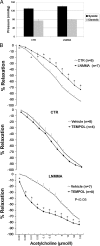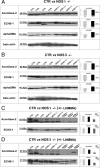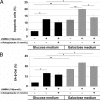The Krebs cycle and mitochondrial mass are early victims of endothelial dysfunction: proteomic approach
- PMID: 19095954
- PMCID: PMC2631316
- DOI: 10.2353/ajpath.2009.080650
The Krebs cycle and mitochondrial mass are early victims of endothelial dysfunction: proteomic approach
Erratum in
- Am J Pathol. 2009 Mar;174(3):1120.. Ciszar, Anna [corrected to Csiszar, Anna]; Krasnikof, Boris [corrected to Krasnikov, Boris]
Abstract
Endothelial cell dysfunction is associated with bioavailable nitric oxide deficiency and an excessive generation of reactive oxygen species. We modeled this condition by chronically inhibiting nitric oxide generation with subpressor doses of N(G)-monomethyl-L-arginine (L-NMMA) in C57B6 and Tie-2/green fluorescent protein mouse strains. L-NMMA-treated mice exhibited a slight reduction in vasorelaxation ability, as well as detectable abnormalities in soluble adhesion molecules (soluble intercellular adhesion molecule-1 and vascular cellular adhesion molecule-1, and matrix metalloproteinase 9), which represent surrogate indicators of endothelial dysfunction. Proteomic analysis of the isolated microvasculature using 2-dimensional gel electrophoresis and matrix-assisted laser desorption/ionization time-of-flight mass spectroscopy revealed abnormal expression of a cluster of mitochondrial enzymes, which was confirmed using immunodetection. Aconitase-2 and enoyl-CoA-hydratase-1 expression levels were decreased in L-NMMA-treated animals; this phenotype was absent in nitric oxide synthase-1 and -3 knockout mice. Depletion of aconitase-2 and enoyl-CoA-hydratase-1 resulted in the inhibition of the Krebs cycle and enhanced pyruvate shunting toward the glycolytic pathway. To assess mitochondrial mass in vivo, co-localization of green fluorescent protein and MitoTracker fluorescence was detected by intravital microscopy. Quantitative analysis of fluorescence intensity showed that L-NMMA-treated animals exhibited lower fluorescence of MitoTracker in microvascular endothelia as a result of reduced mitochondrial mass. These findings provide conclusive and unbiased evidence that mitochondriopathy represents an early manifestation of endothelial dysfunction, shifting cell metabolism toward "metabolic hypoxia" through the selective depletion of both aconitase-2 and enoyl-CoA-hydratase-1. These findings may contribute to an early preclinical diagnosis of endothelial dysfunction.
Figures







References
-
- Koenig W. Cardiovascular biomarkers: added value with an integrated approach? Circulation. 2007;116:3–5. - PubMed
-
- Khot UN, Khot MB, Bajzer CT, Sapp SK, Ohman EM, Brener SJ, Ellis SG, Lincoff AM, Topol EJ. Prevalence of conventional risk factor in patient with coronary heart disease. JAMA. 2003;290:898–904. - PubMed
-
- Lowell BB, Shulman GI. Mitochondrial dysfunction and type 2 diabetes. Science. 2005;307:384–387. - PubMed
-
- Vasan RS. Biomarkers of cardiovascular disease: molecular basis and practical considerations. Circulation. 2006;113:2335–2362. - PubMed
Publication types
MeSH terms
Substances
Grants and funding
LinkOut - more resources
Full Text Sources
Other Literature Sources
Molecular Biology Databases
Miscellaneous

